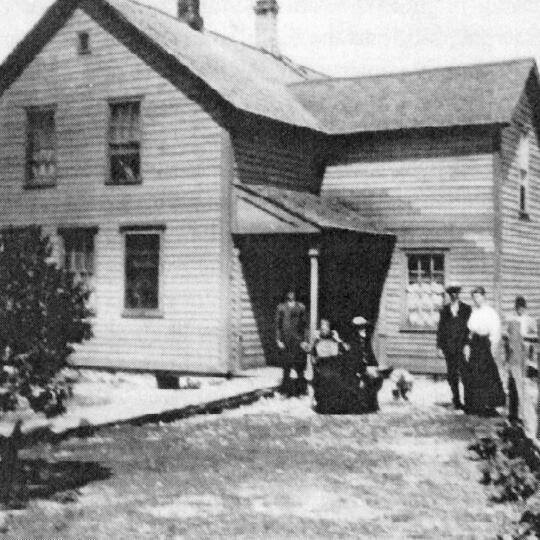Adapted from his book Good Harbor Michigan with additional information from the Grand Traverse Herald The settlement of Leelanau by Euro-Americans began as early as the late 1830s but their flow rapidly increased after 1855. Traverse City was growing even more rapidly and the Grand Rapids and Indiana railroad arrived there on November 15, 1872. Almost immediately there was talk and excitement about a train in Leelanau. The talks got serious in January 1885 when a group of businessmen discussed the possibility of a narrow gauge railroad between Maple City and Good Harbor, according to the Leelanau Enterprise.
When I first read about this possible railroad I was quite surprised and excited as I had never heard of such discussion or possibility. As I read more and more about it I realized the train could have cut through the Bufka farm. What would have been the implications of that I wondered.
The reporting in the Leelanau Enterprise was exciting but written from a Good Harbor viewpoint. The Grand Traverse Herald reported it a little differently.
On Jan. 8, 1885 the Herald reported that the discussion was about a narrow gauge railroad from Maple City to the Lake. Talk at that meeting centered on two possibilities to Lake Michigan, one along the west shore of Lime Lake and the other through Burdickville to Glen Haven. On Jan. 19 the people voted unanimously to solicit subscriptions for rail service to Glen Haven. There were no representatives from Good Harbor or Leland.
In contrast, on Jan. 25, 1885 the Leelanau Enterprise reported that “It has been decided to build a narrow gauge Rail Road from Maple City to Good Harbor.” The article enthusiastically reported on the progress already made and the advantages to the two communities by saying, “Stock is being fast taken, and the road will, no doubt, be completed during the coming season. This is a matter of no little importance to the people of this section; and, the lively interest they are taking, plainly shows their appreciation of its value. Mr. Charles Kropp has contracted to grade, furnish and lay the ties for one mile, free of charge. When this road is constructed, the valuable hard-wood timber growing between Maple City and Good Harbor, need no longer be slashed down and burned for the purpose of getting it out of the way; as manufacturies will be greatly encouraged at Maple City, and cordwood can be brought to the lake shore and shipped to Milwaukee and Chicago.”
On Jan. 29, the Enterprise encouraged farmers to take subscriptions as the railroad would enhance their farming operation. The rail service would of course benefit the saw mill at Maple City by making it accessible to markets on the Lake.
At the Feb. 2 meeting there were 60 representatives from Solon, Cleveland, and Glen Haven as well as Maple City. They decided on two subscriptions: one from Maple City to Glen Haven and the other to Good Harbor.
The Enterprise made it look like the railroad was a sure proposition but on February 12 the paper reported that “Mr. Chamberlain of Glen Haven, is at work trying to so change the route of the proposed Rail Road; as to bring it from Maple City to Glen Haven, instead of to Good Harbor. In furtherance of this scheme, we are informed, he has made the very liberal, though profitable offer, to build the road from Glen Haven to Burdickville, if other parties will contract to complete it to Maple City.” Chamberlain had many supporters. Suddenly, this sure venture is in jeopardy, it appears, but the article expressed optimism that the people “are too much alive to their own interests to allow the intervention of one man to break up, or in any way disturb their plans and purposes. They have too long suffered the want of a market for their timber and farm produce, they have too long been compelled to repair to some neighboring town for any little article of necessity, they have too long been obliged to accept of meager prices for their hard work for productions, they have too long known the inconvenience of reaching Traverse City; killing both man and beast in their attempt to do so, they too well know all these things and a multitude of others, to submit to letting this grand opportunity be lost, when it is already within their grasp….The building of this road from Maple City to Glen Haven, means that Good Harbor is forever doomed to be without one.” It urged action to prevent this impending disaster from taking place.
The Leelanau Enterprise encouraged people to take stock in this company. Benefits to Leland were now being touted if the train could continue from Good Harbor to Leland. Meetings took place in March and April in Leland to encourage this kind of thinking and investment. H. D. Pheatt, retired Lakes Captain and owner of a dock and saw mill at Good Harbor, argued vigorously for Good Harbor.
The people attending were told they needed only about $20,000 from each community and that Maple City already had nearly that amount. Charles Kropp reiterated his offer to build a mile of track with his own money and iron even though talk had now moved from narrow gauge to regular gauge.
And that is the end of the recorded story. The road was never built. What happened to these plans? What happened to the railroad? The Herald reported nothing after February 1885 and the Enterprise stopped reporting in April but no resolution of this venture was reported although people continued to talk about rail service in Leelanau. The arrival of rail service in late 1892 will be the subject of my next column.









